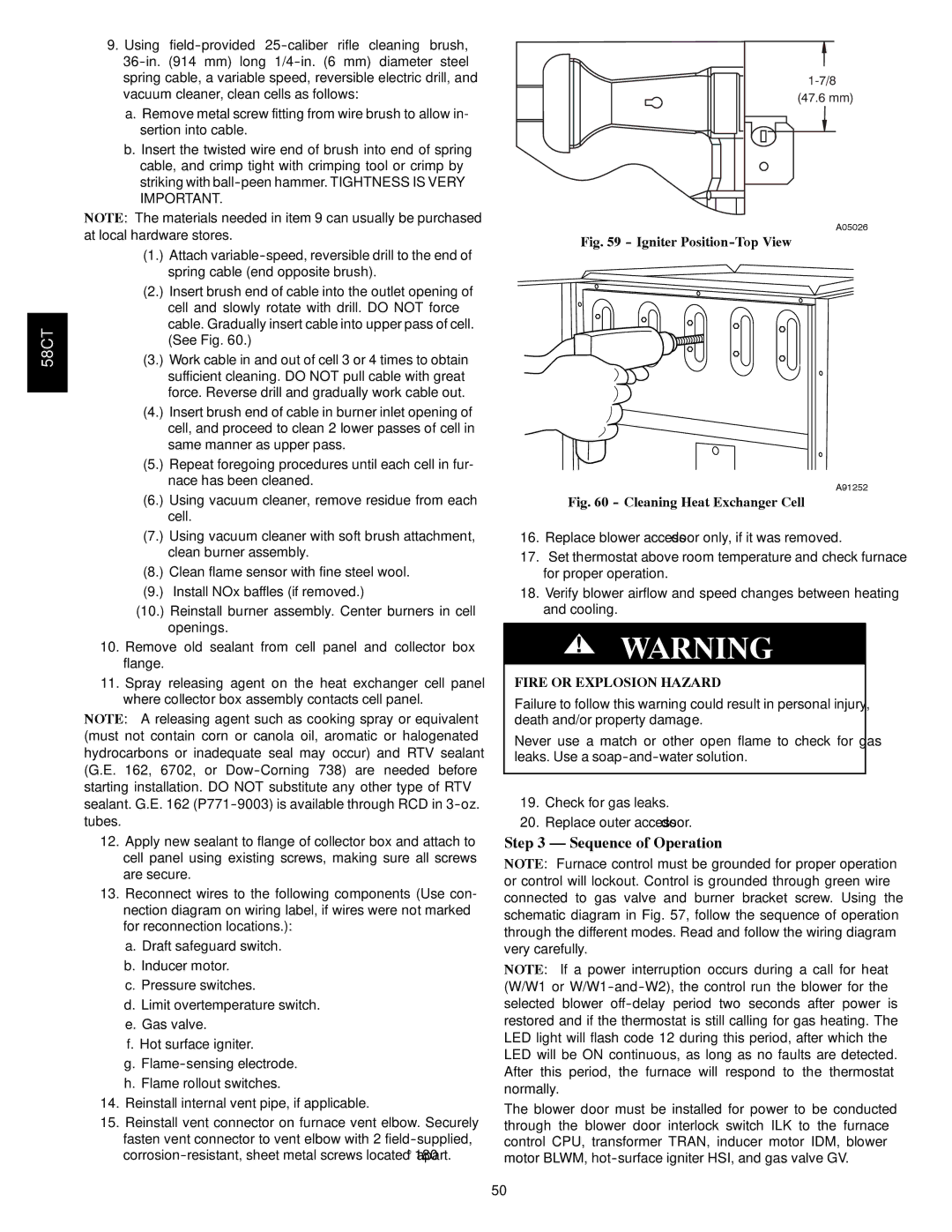
58CT
9.Using
a.Remove metal screw fitting from wire brush to allow in- sertion into cable.
b.Insert the twisted wire end of brush into end of spring cable, and crimp tight with crimping tool or crimp by striking with
NOTE: The materials needed in item 9 can usually be purchased at local hardware stores.
(1.) Attach
(2.) Insert brush end of cable into the outlet opening of cell and slowly rotate with drill. DO NOT force cable. Gradually insert cable into upper pass of cell. (See Fig. 60.)
(3.) Work cable in and out of cell 3 or 4 times to obtain sufficient cleaning. DO NOT pull cable with great force. Reverse drill and gradually work cable out.
(4.) Insert brush end of cable in burner inlet opening of cell, and proceed to clean 2 lower passes of cell in same manner as upper pass.
(5.) Repeat foregoing procedures until each cell in fur- nace has been cleaned.
(6.) Using vacuum cleaner, remove residue from each cell.
(7.) Using vacuum cleaner with soft brush attachment, clean burner assembly.
(8.) Clean flame sensor with fine steel wool.
(9.) Install NOx baffles (if removed.)
(10.) Reinstall burner assembly. Center burners in cell openings.
10.Remove old sealant from cell panel and collector box flange.
11.Spray releasing agent on the heat exchanger cell panel where collector box assembly contacts cell panel.
NOTE: A releasing agent such as cooking spray or equivalent (must not contain corn or canola oil, aromatic or halogenated hydrocarbons or inadequate seal may occur) and RTV sealant (G.E. 162, 6702, or
12.Apply new sealant to flange of collector box and attach to cell panel using existing screws, making sure all screws are secure.
13.Reconnect wires to the following components (Use con- nection diagram on wiring label, if wires were not marked for reconnection locations.):
a.Draft safeguard switch.
b.Inducer motor.
c.Pressure switches.
d.Limit overtemperature switch.
e.Gas valve.
f.Hot surface igniter.
g.
h.Flame rollout switches.
14.Reinstall internal vent pipe, if applicable.
15.Reinstall vent connector on furnace vent elbow. Securely fasten vent connector to vent elbow with 2
(47.6 mm)
A05026
Fig. 59 - Igniter Position-Top View
A91252
Fig. 60 - Cleaning Heat Exchanger Cell
16.Replace blower access door only, if it was removed.
17.Set thermostat above room temperature and check furnace for proper operation.
18.Verify blower airflow and speed changes between heating and cooling.
!WARNING
FIRE OR EXPLOSION HAZARD
Failure to follow this warning could result in personal injury, death and/or property damage.
Never use a match or other open flame to check for gas leaks. Use a
19.Check for gas leaks.
20.Replace outer access door.
Step 3 — Sequence of Operation
NOTE: Furnace control must be grounded for proper operation or control will lockout. Control is grounded through green wire connected to gas valve and burner bracket screw. Using the schematic diagram in Fig. 57, follow the sequence of operation through the different modes. Read and follow the wiring diagram very carefully.
NOTE: If a power interruption occurs during a call for heat (W/W1 or
The blower door must be installed for power to be conducted through the blower door interlock switch ILK to the furnace control CPU, transformer TRAN, inducer motor IDM, blower motor BLWM,
50
